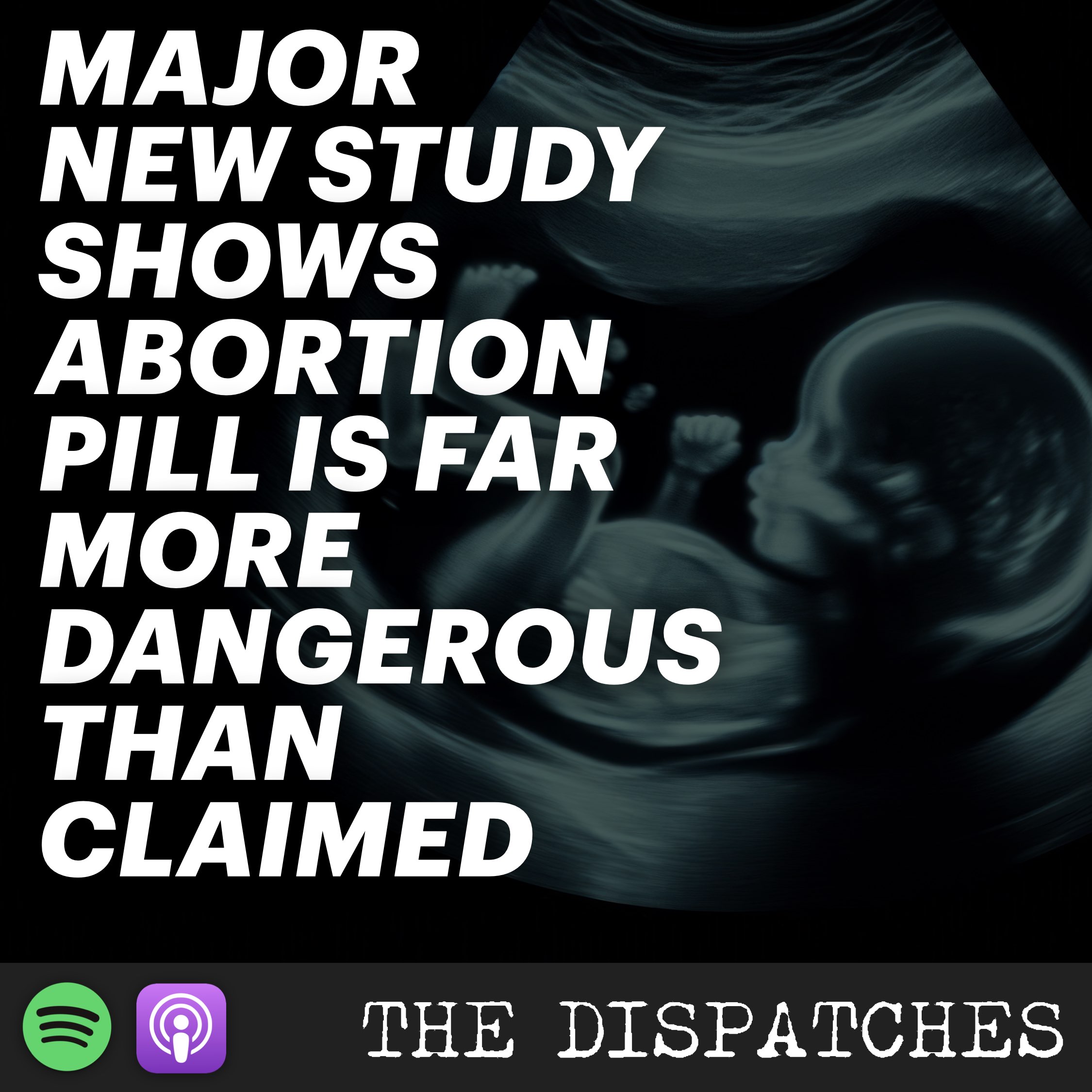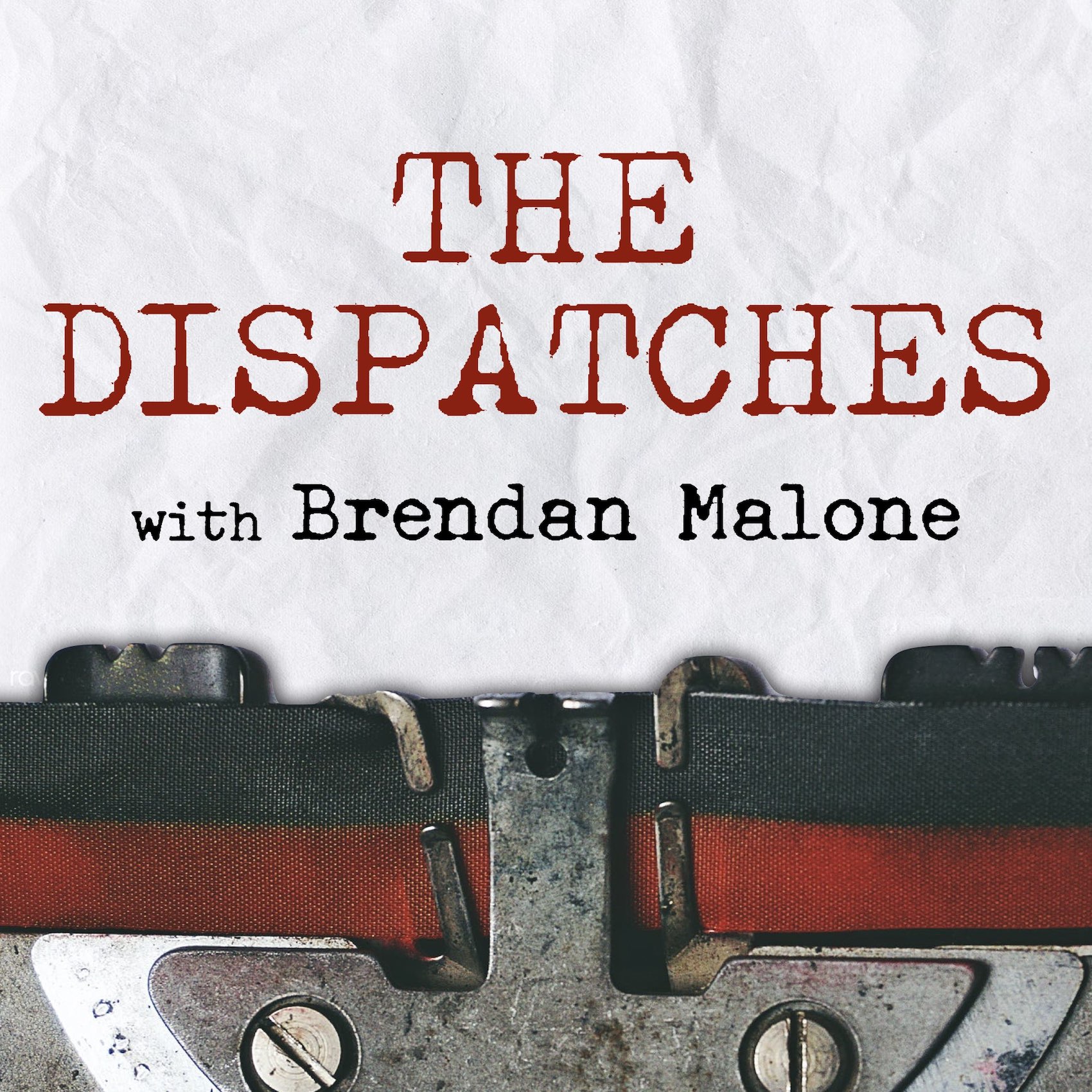[00:00:00] Hi everybody. Welcome back to the Dispatchers podcast. My name is Brendan Malone. It is great to be back with you again and today's topic of conversation. A major new study shows that the abortion pill is 22 times more dangerous than the FDA claims.
[00:00:21] Hi, my name is Brendan Malone and you're listening to the Dispatchers, the podcast that strives to cut through all the noise in order to challenge the popular narratives of the day with some good old fashioned contrarian thinking. You might not always agree, but at least you'll be taking a deeper look at the world around you.
[00:00:39] Before we jump into this very important new study, a huge thank you to all of our patrons. If you value our work, you're getting benefit from it and you want to get access to exclusive content, then please Support
[email protected] leftfootmedia you you can also support us monthly via our substack page as well. I will post a link for both of those in today's show Notes. Right, let's jump into this very important topic of conversation and explore this brand new report just published only a couple of days ago, which shows that the abortion pill is far more dangerous than claimed and it's also far more dangerous than the labelling suggests. This particular product, the abortion pill, is known by different titles. Sometimes people refer to it by its official product product name, like Mifeprostone or Mifeprostone and Misoprostol. It's actually a two stage abortion pill. In America it's called Mifeprex. Different parts of the world have different names for it and so sometimes people will refer to it by its official drug label title. Sometimes it's called a medical abortion, sometimes it's called an early medical abortion, sometimes it's called a chemical abortion. But this is what this study is looking at and it's looking at hard data and a lot of it. We'll get to that in just a second. But why this is so important and why this matters for not just America, the study was conducted in the United States is because this particular method of abortion is now becoming the preferred, if not the primary method of abortion in a lot of places around the world, including right here in New Zealand. And as you will hear in this particular podcast, the data in New Zealand and also other countries actually backs up and echoes exactly what this report has found. So this is not an outlier and we shouldn't really be shocked by this. And at the end of the podcast today, I will explain why I think this is becoming the preferred method of abortion. And then I will also leave you with a recommendation for what you can actually do about this in relation to this brand new report. So before we get into that though, let's go backwards a little bit and explore from this report a little bit of background on the fda, the Food and Drug Administration approval and regulation of Mifeprostone in America. So let me read to you from this report. Mifeprostone was developed by the French pharmaceutical company Roussel Euclaf SA and brought to the United States at the urging of President Clinton and after congressional pressure. So those who might not remember or might not be aware, that is the 1990s we are talking about. So it's only actually a relatively recent development. The FDA approved it under a little used approval process for certain new drug products that have been studied for their safety and effectiveness in treating serious or life threatening illnesses and that provide meaningful therapeutic benefit to patients over existing treatments. Thus, to grant approval in this manner, the FDA had to consider an unwanted pregnancy a serious or life threatening illness. And I think most people, even those who might be pro choice who are honest, would say that is not a fair assessment at all. And they also had to find that mifeprostone was more effective than surgical abortion in treating what has been labelled as an illness. The FDA's decision cites minimal data. They cite clinical Trials with only 859 participants in the United States and and another one with 1,800 participants in France. And as you'll see in a moment when we look at this brand new report, their report, the amount of people that they have explored is gargantuan compared to this. The original FDA approved drug label for Mifeprex, which is what it's known under its brand name in the United States. So here you would talk About MifeProstone from September 2000 indicated use of the drug for the quote unquote medical termination of intrauterine pregnancy through through 49 days pregnancy. It required several modest safeguards for women's health. And here's the quote. Treatment with Mifeprex and Misoprostol for the termination of pregnancy requires three office visits by the patient. Mifeprex should be prescribed only by physicians who have read and understood the prescribing information. Mifeprex may be administered only in clinical, medical office or hospital, but by or under the supervision of a physician able to access the gestational age of an embryo and to diagnose ectopic pregnancies. Physicians must also be able to provide surgical intervention in cases of incomplete abortion or severe bleeding or have made plans to provide such care through others and be able to assure patient access to medical facilities equipped to provide blood transfusions and resuscitation if necessary. So straight away, there's a lot of red flags here about potential risks associated with this brand new abortion method. And you can also see something that has radically slipped over the successive years, including right here in New Zealand. As you'll hear in a moment, there is now a complete disregard for this kind of level of safety and protection for the woman who are going to be using this particular product. During the Obama and Biden administrations, the FDA chipped away at these initial safeguards risking women's health in order to increase access to abortion under the current risk evaluation and mitigation strategy in effect since 2023. One, a mifeprostone abortion now requires as little as one telehealth visit. So that's a phone call. That's what a telehealth service is. You ring a telephone number. A telehealth visit with any approved healthcare provider, not necessarily a physician. Two, a woman may self administer drugs obtained from a mail order pharmacy. And three, the prescriber need not report any adverse events unless he or she knows that a patient has died. That is an astounding decrease in the regulations. And you can see here the massive erosion of protections for the females who are going to be using this particular product. The current FDA approved drug label refers to the results of 10 clinical trials with a total of 30,966 patients. That is a total of all of the participants in all 10 of those trials, less than 0.5% of whom reportedly experienced serious adverse reactions. And I'll explain why in a moment. They have made that particular claim that this is less than 0.5% of the people who reportedly experience serious adverse reactions. But these figures are based entirely on data from trials taking place more than a decade ago. And then they also go on to actually talk about and show a graph with the quote, unquote, market share of chemical abortion. And they say this increased access to chemical abortion has coincided with a rapid increase in its prevalence. Chemical abortions, the vast majority of which are performed using a combination of mifeprostone and misoprostol, now account for roughly two thirds of all abortions in the United States. So 66% approximately. And this graph shows a massive increase from the 2000s, where it's sitting close to about 0% right up to now, where it's sitting just beneath 70% of all abortions. Danko Laboratories boasts that more than 5 million US women have used its abortion pill since it was approved in 2000. Thus, it has become increasingly important to understand the risks and harms to women from chemical abortion in general and from mifeprostone in particular. And this mirrors exactly what we see here in New Zealand. We'll get to that particular point in a minute. So here's the situation as it currently sits. And this is a similar situation in a lot of countries around the world, including right here in New Zealand. Even though the regulations and the processes for regulation are a little bit different and the trajectory of that is slightly different, the situation in general is similar. This has now, as I said, become a preferred, if not the primary method of abortion in a lot of places. And then the report goes on to explain how they identified mifeprostone abortions and how they identified serious adverse effects that were experienced by the woman who used the this particular product. And I won't go into all of the details here. I will post a link and you can read the study for yourself from the Ethics and Public Policy center in the United States. And I guess one really important question in all of this was how big was the sample size of this new report that we are talking about today? Was it just a small number of cases? Was it an average number of cases? No, this was, as I said earlier, gargantuan. Compared to the previous data, this study involved 865,727 prescribed mifer prostone abortions from 2017 to 2023. That is almost 1 million uses of the abortion pill that was studied. This is huge. And this is why this is now the largest known study of the abortion pill ever. And as you saw and heard from the earlier data, it is gargantuan. It completely outstrips all of the previous reports and surveys because their sample sizes were much smaller than this. This is massive. What they found in their key findings. And this is the important bit, 10.93% of women experience sepsis, infection, haemorrhaging or another serious or life threatening adverse event within 45 days following a mifeprostone abortion, far greater than the summary figure of less than 0.5% in clinical trials reported on the drug label. Simply stated, mifeprostone as used in real world conditions is not safe and effective. Our real world post market observational study of mifeprostone is to our knowledge the most comprehensive study of chemical abortion safety ever conducted in the US we identify and include 865,727 prescribed mifeprostone abortions, 28 times as many as were included in all FDA cited clinical trials combined. So all of the trials that the FDA used, if you group them all together, the total number of participants in this new report is 28 times greater than all of the previous trial participants, all grouped together. Our data set is more recent, no earlier than 2017. While the FDA approval of mifeprostone relies entirely on data from more than a decade ago. We'll come back to that point in just a second. The women in our data set are broadly representative of the women who obtain Mifer prostone abortions in the us. They are not a pre screened group of generally healthy women recruited into various clinical trials conducted at different times around the world. So in other words, they are actually looking at the real world effects in the field, in the flesh, as they actually harm women. The women in our data set receive or fail to receive pre and post abortion healthcare of the real world quality that prevails in the USA today, not the carefully controlled regimen of care that ordinarily prevails in a clinical trial. So again, they are looking at what happens in a population when you release a new product. And that is really important, not the controlled and much less risky situation of a clinical trial environment. And one other really important finding here, aside from the fact that they have now found that 1 in 10 abortions involving Mifeprostone, the abortion drug, result in adverse harms to women, what this data also shows is that the real world rate of serious adverse events following mifeprostone abortions is at least 22% times higher than the summary figure of less than 0.5% in clinical trials reported on the drug label. So the drug label is offering a risk factor or a cause of adverse events, serious adverse events, that is 22 times lower than what the actual real world data in this gargantuan report has actually revealed. As I said, this is hugely important and this has massive implications for New Zealand. And by the way, remember earlier I talked about the fact that they were referring to data from a decade ago. Well, going back a decade, we already had indications around the world that this particular product was actually more dangerous. Approximately 10 years ago, I was asked to write an article for an ethics website overseas about some brand new data that had been published by the Therapeutic Goods Organization in Australia and another source in Aussie as well. And both of those sources indicated that women were far more likely to require medical follow up if they used a mifeprostone abortion than what they were if they had A surgical abortion. So already 10 years ago we had data indicating and echoing exactly what we are seeing here. Not just that, but the latest abortion report here in New Zealand, published only at the end of last December 2024, echoes and backs up once again exactly what we are seeing here. What that report showed was that the number of women in New Zealand now experiencing adverse effects from their abortions has almost doubled since 20.
[00:15:04] This is a massive increase. In 2021, approximately 1.3% of New Zealand women having abortions experienced adverse effects. In the brand new report just published in December, it is now 2.2%. That is almost a doubling of the number of New Zealand women who are now experiencing adverse effects from abortion. And it is very clear in the data what is driving this. There is now, just like in the United States, a massive increase in the use of the mifeprostone abortion pill. In this case here in New Zealand, after the passing of the Extreme Abortion Legislation Act 2020. And I call it extreme because the way that law is crafted, if you can find an abortionist who was willing to carry out the abortion, you can now legally have an abortion right up to and even during birth in this country. There is nothing in the legislation to prevent that from happening. And I think most people would say, yes, that is a particularly extreme piece of legislation. And after the introduction of that piece of legislation in 2020, we also introduced a quote unquote telehealth Service. This is an 0800 free call number that you can ring and they will send you television the mifeprostone abortion pills so that you can carry out an abortion at home. And I don't think it's unreasonable to point out at this particular juncture that this looks and sounds exactly like a state operated and state sponsored form of DIY backstreet abortion. And I'm sure I don't need to point out the irony in that because people have been for years claiming that our laws and our legalisation of abortion, and our liberalisation in particular was supposed to make things safer for women. And in particular we were supposed to be moving away from backstreet abortions. Here we are back in that very situation and in this case it is the government itself that is sponsoring and facilitating these DIY home based abortions using this mifeprostone drug. So there's a massive increase in the use of mifeprostone in this country as a result of all of this. And hardly surprisingly, we see echoed exactly what we are seeing this report indicating that this is causing greater adverse effects. As a result, the number of adverse effects, as I said, to women who are experiencing abortions in this country has now almost doubled since 2021, from 1.3% then to 1.6% in 2022. And now in the brand new report just published last year, 2.2% in 2023. That is an almost doubling of the number of adverse effects in just a three year period in our country alone. And when you look at the table provided in the official government report that was published in 2024, in December in this country called number of complications at time of abortion by procedure type. So this is telling us the number of complications and it breaks it down and shows us how many of these various different types of complications occurred under each of the different categories of abortion. And there are three categories listed here. Early medical abortion, they call that ema, then surgical abortion, and then later medical abortion. And with almost every single one of the different types of adverse events that are listed in this table, the abortion pill mifeprostone is markedly higher. There are literally only three exceptions to that rule. So what that means Is, out of 10 possible adverse effects that are recorded here that women have experienced in only three of those adverse events, is the abortion pill not higher. And in most cases, markedly higher. But also in some cases, not only are things markedly higher, we'll talk about that in just a second. But also what you see is that in some cases there are zero incidents of a particular adverse effect when you are using a surgical or a later medical abortion, while there are actually adverse events that are caused to women by the early medical abortion that don't occur in the other two categories. And as I said, some of these are really stark. So, for example, retained placenta or products, what they mean there is fetal remains, products of conception is what they're referring to, to there. With a surgical abortion, there were 25 cases of that particular adverse event. With later medical abortions, there were 24 cases of that particular adverse event. With the early medical abortion, mifeprostone, there were 135 cases of that adverse event infection. There were three recorded cases of infections from surgical abortion in New Zealand in 2023. There were zero recorded cases of infection from later medical abortion in 2023. Meanwhile, there were 67 cases of infection recorded as being caused by the early medical abortion method, the mifeprostone pill. In 2023, there were 22 incidents involving mifeprostone of retained placenta products and infection. So the combination 22 cases of that, there was zero incidence of that involving surgical and zero involving later medical abortion. This is serious. And what makes this, I think, so scandalous is that when this report was published last year, the mainstream media and other commentators were completely quiet. And it was so noticeable, the absence of any commentary at all. And not just that, but in the introduction to this report, the official health authorities in our country praised this report and the data contained in the report, saying that it showed that things were moving in a positive direction.
[00:21:23] There wasn't even an acknowledgement of the fact that there are some issues here that require at the very least some sort of investigation. Because remember, this product has been sold to the country as being safer. That's exactly what we were told over successive years in this country, that early medical abortions involving mifeprostone were safer. That claim, as you've heard me state earlier, was never the truth, but that's what we were told. And what this report, now the latest report is showing us that this is actually proving not to be the case at all. And it is so glaringly obvious that this is not the case. There should be at the very least, as I said, an investigation in this country into exactly what is going on here. But not only is that not happening, but there has been absolute silence about this particular and very serious change in the state of affairs. And as I said, you would think that people who are claiming publicly that their commitment is to the safety of women when it comes to abortion would be crying from the rooftops. We've got a problem here. When the number of adverse effects caused to women by abortions in this country has almost doubled in a three year period, they should be making noise about this, but no one's saying anything apart from the pro life community. Why? Well, I think because ultimately there is a greater commitment to other priorities in some cases. I am absolutely convinced that there are people who don't want to talk publicly about this because this would create a threat to the ideological position that they have staunchly defended for so long. And it would also challenge many of the claims. And I think in certain cases you have politicians who have basically blithely gone along and supported this liberalisation and the increased use of this particular product. And they don't really want to draw attention to the fact that they have been part of contributing to these adverse outcomes that we are seeing here. Secondly, and as I said at the very beginning, I would explain why I think there has been such a push towards this particular method of abortion. I think there is the fact that that this is a brutally efficient and cost effective way of carrying out abortion. This is the cold hard reality of this. This is a very cheap way of having abortion in New Zealand society. Someone rings an 0800 number and the abortion pills are delivered to them and then they carry out the abortion in their own home. You don't have to be a rocket scientist or the world's greatest economist to recognise how that involves a whole lot of cost cutting steps at when we are now experiencing a healthcare system under great strain. And no small reason for that, by the way, and this is tragically ironic, is the fact that we just have not had enough children. We have an increasingly aging population, we have not had enough children to sustain things like, for example, our healthcare system. Because what you need is you need new young workers who are paying tax. And if you don't have enough of those, then what you are going to experience is an aging population, increasing demand on those resources and the cost of those resources is not going to be as easily met. So you are going to look for cost cutting measures where you can. And this is a brutally efficient cost cutting measure. And then when you add into that fact the cold and brutal economics, and I think personally abhorrent utilitarian economics of the fact that if someone has an abortion, then potentially the state is also saving a whole lot of other costs that they wouldn't have to pay out through the welfare system to people in a lot of these situations raising children where they would require state intervention in the form of welfare. This is a brutally cost efficient abortion method. And it is absolutely scandalous that we are not shouting from the rooftops, as I said, about the harms that this particular methodology is causing. Sadly, I think in our country, at the rate we are going, we are now speeding towards an outcome like we've already seen in cases in America and very recently of women who will die as a direct result of using mifeprostone in this country. We've had very infamous high profile cases of exactly this in the United States recently. And at the rate New Zealand is going, sadly, I think we are on trajectory to start experiencing exactly these kinds of outcomes in our country. And those who remained silent and who had the power to actually do something about this, they will be the ones who are ultimately morally culpable for exactly what is going on here. Those who have remained silent, who have not acted when they had the power to act and intervene here. In other words, those in authority and those in authority who actually allowed this situation to arise because they did not take care and prioritize a genuine scrutiny of what was actually being proposed in the way of legislative changes rather than just allowing ideology to and very outdated and emotive cliches and sloganeering to actually dictate the way that they voted in regards to all of this. So there are some serious issues here that demand our attention. What can we do about this? Well, can I suggest to you, regardless of where you're living, but particularly if you live in New Zealand, I think it would be a good idea to get in touch with your local MP and to actually let them know about this brand new report, to let them know about the data in the New Zealand abortion report and actually have a conversation with them about your concerns and say that you would actually like them to take some action at the parliamentary level about this. Because regardless of whether you are pro life or pro choice on this issue, there is a serious problem here and it is now rapidly driving us towards a deadly outcome for women in this country and everyone should care about that fact. Even if you disagree with me that there is a moral problem in the fact that every abortion results in a deadly outcome for an innocent unborn child, Surely at the very least we can all agree that the use of abortion drugs in this country should not be allowed to go unchallenged if those drugs present a serious risk to the woman who will be using them.
[00:28:05] Thanks again for tuning in. Don't forget, live by goodness, truth and beauty, not by lies. And I'll see you next time on the Dispatchers.
[00:28:18] The Dispatchers podcast is a production of Left Foot Media. If you enjoyed this show, then please help us to ensure that more of this great content keeps getting made by becoming a patron of our
[email protected] leftfootmedia link in the show notes. Thanks for listening. See you next time on the Dispatches.






